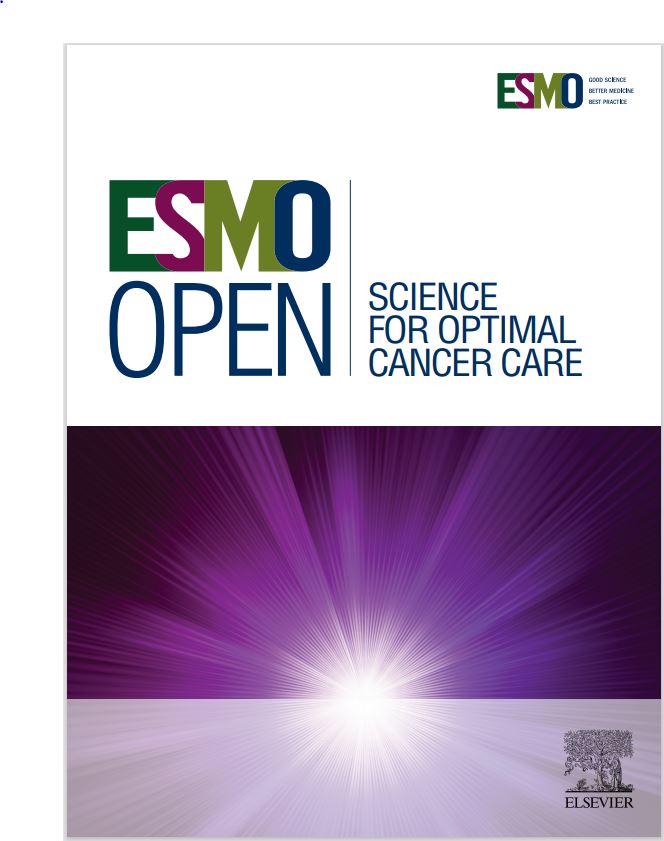NALIRIFOX in the treatment of metastatic pancreatic ductal adenocarcinoma: an exploratory analysis of real-world data
IF 8.3
2区 医学
Q1 ONCOLOGY
引用次数: 0
Abstract
Background
NALIRIFOX, a triplet chemotherapy regimen combining nanoliposomal irinotecan, 5-fluorouracil/leucovorin, and oxaliplatin, demonstrated superior survival outcomes versus gemcitabine plus nab-paclitaxel in the NAPOLI 3 trial for metastatic pancreatic ductal adenocarcinoma (mPDAC). However, its performance in routine clinical practice remains underexplored.
Patients and methods
This multicenter retrospective study evaluated the real-world efficacy and safety of NALIRIFOX as first-line treatment in 80 patients with mPDAC. Primary endpoints were time to failure of strategy (TFS) and overall survival (OS). Secondary endpoints included treatment-related toxicity, disease control rate (DCR), and molecular subgroup analyses based on homologous recombination repair mutations (HRRm) and KRAS status.
Results
Median TFS and OS were 5.66 and 11.15 months, respectively, with improved outcomes (TFS 6.05 months; OS 12.92 months) in patients meeting strict NAPOLI 3 inclusion criteria. DCR was 57.5%, and grade 3-4 toxicities occurred in 22.5% of patients—lower than reported in randomized trials. HRRm patients (20%) achieved significantly prolonged TFS (7.96 versus 5.23 months, P = 0.049) and OS (16.24 versus 11.11 months, P = 0.043). KRAS G12D/V mutations were associated with worse OS (11.15 months versus not reached, P < 0.05), but not TFS.
Conclusions
This first real-world analysis of NALIRIFOX confirms its clinical effectiveness and manageable toxicity in an unselected patient population. The favorable outcomes in HRRm subgroups and the prognostic impact of KRAS variants underscore the need for molecular stratification in guiding first-line therapy for mPDAC.
NALIRIFOX治疗转移性胰腺导管腺癌:对真实世界数据的探索性分析。
背景:NALIRIFOX是一种联合纳米脂质体伊立替康、5-氟尿嘧啶/亚叶酸蛋白和奥沙利铂的三重化疗方案,在转移性胰腺导管腺癌(mPDAC)的NAPOLI 3试验中显示出比吉西他滨加nab-紫杉醇更优越的生存结果。然而,其在常规临床实践中的表现仍未得到充分探讨。患者和方法:这项多中心回顾性研究评估了NALIRIFOX作为80例mPDAC患者一线治疗的实际疗效和安全性。主要终点是策略失败时间(TFS)和总生存期(OS)。次要终点包括治疗相关毒性、疾病控制率(DCR)、基于同源重组修复突变(HRRm)和KRAS状态的分子亚群分析。结果:中位TFS和OS分别为5.66和11.15个月,符合严格的NAPOLI 3纳入标准的患者预后改善(TFS为6.05个月,OS为12.92个月)。DCR为57.5%,3-4级毒性发生在22.5%的患者中,低于随机试验报告。HRRm患者(20%)显著延长了TFS(7.96个月vs 5.23个月,P = 0.049)和OS(16.24个月vs 11.11个月,P = 0.043)。KRAS G12D/V突变与较差的OS相关(11.15个月vs未达到,P < 0.05),但与TFS无关。结论:NALIRIFOX的首次实际分析证实了其在未选择的患者群体中的临床有效性和可控毒性。HRRm亚组的良好结果和KRAS变异对预后的影响强调了分子分层指导mPDAC一线治疗的必要性。
本文章由计算机程序翻译,如有差异,请以英文原文为准。
求助全文
约1分钟内获得全文
求助全文
来源期刊

ESMO Open
Medicine-Oncology
CiteScore
11.70
自引率
2.70%
发文量
255
审稿时长
10 weeks
期刊介绍:
ESMO Open is the online-only, open access journal of the European Society for Medical Oncology (ESMO). It is a peer-reviewed publication dedicated to sharing high-quality medical research and educational materials from various fields of oncology. The journal specifically focuses on showcasing innovative clinical and translational cancer research.
ESMO Open aims to publish a wide range of research articles covering all aspects of oncology, including experimental studies, translational research, diagnostic advancements, and therapeutic approaches. The content of the journal includes original research articles, insightful reviews, thought-provoking editorials, and correspondence. Moreover, the journal warmly welcomes the submission of phase I trials and meta-analyses. It also showcases reviews from significant ESMO conferences and meetings, as well as publishes important position statements on behalf of ESMO.
Overall, ESMO Open offers a platform for scientists, clinicians, and researchers in the field of oncology to share their valuable insights and contribute to advancing the understanding and treatment of cancer. The journal serves as a source of up-to-date information and fosters collaboration within the oncology community.
 求助内容:
求助内容: 应助结果提醒方式:
应助结果提醒方式:


